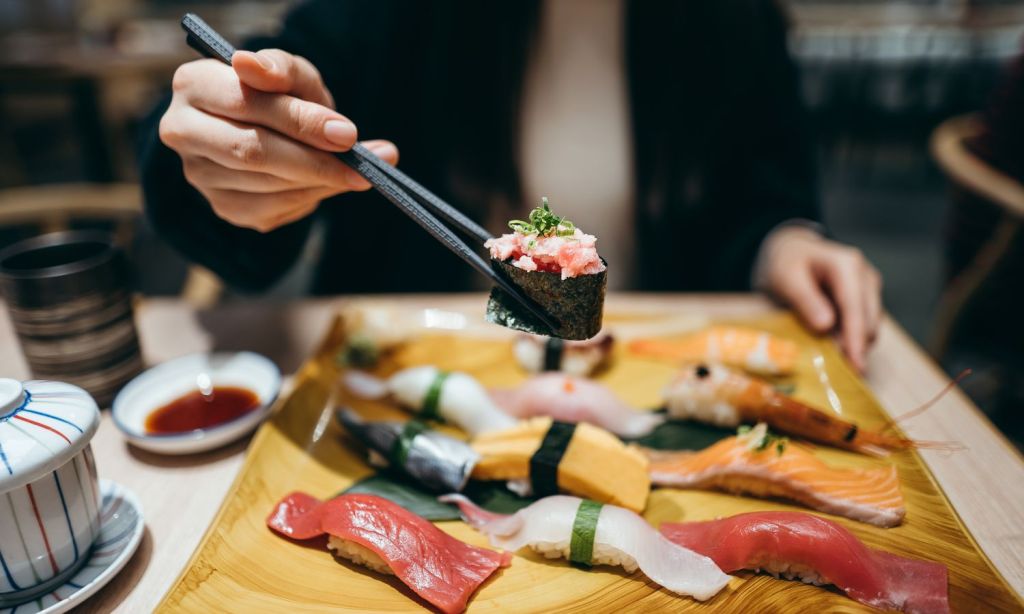The dining experience in Japan is as much about tradition and etiquette as it is about taste. The rules are unwritten yet deeply ingrained. While locals are forgiving of foreign visitors who may not be familiar with all the customs, by making an effort to learn and respect the rules, you’ll be rewarded with a sense of connection to the culture and will be able to enjoy your meals to the fullest.
From the handling of chopsticks to the gentle murmur of gratitude before and after each meal, these customs are a doorway to understanding Japan’s way of life. Here’s a guide to navigating the world of Japanese table manners.
What You Need to Know About Tables and Seating
Whether you’re in Tokyo or the Nagano prefecture, chances are you’re going to come across a few different restaurants with varying seating styles. There’s the common Shokudo, a small casual restaurant; a Teishoku-ya, which is where you will dine on set menus; and Yatai, the movable food stalls Fukuoka is famous for.
In some Japanese restaurants, they do things a bit differently. Instead of regular chairs and tables, Seiza has low tables and comfy floor cushions on tatami floors. But here’s the catch: you’ve gotta kick off your shoes and slippers at the door, no exceptions.
And when you’re inside, watch your step. Don’t accidentally step on someone else’s cushion. It’s all about respecting their traditions and making the dining experience a blend of comfort and culture that’s uniquely Japanese.

10 Essential Japanese Table Manners
1. Wet Towels Are For Hands (only)
Chances are there will be a wet towel at your table, or one will be presented to you when you sit down. The towel is for your hands only. Don’t wipe your face or mouth with it.
2. Say “itadakimasu”
Waiting for everyone’s order before tucking into your meal is common. It’s also customary to say “itadakimasu, ” meaning “I gratefully receive.” As an added level, if there is a dish that should be eaten right away, you can “osaki ni dozo (please go ahead) or “osaki ni itadakimasu” (allow me to start before you.)
3. Don’t Stick Chopsticks Upright
Placing your chopsticks upright in a bowl of rice resembles a funeral ritual, so avoid doing this. Instead, lay them flat across your plate or chopstick rest when not in use. It’s also considered good manners to put your chopsticks inside the bowl when drinking soup.
If you can avoid it, try not to pass food between chopsticks or cut food with chopsticks. They’re frowned upon in public.
4. Hold Your Bowl
In Western culture, we would never consider holding a bowl, but in Japan, it’s frowned upon not to hold your small bowl of rice or miso soup. Here’s a tip: Hold the bowl in one hand, bring it up to your face and eat your meal. Make sure your posture is straight.

5. Keep Your Elbows Off the Table
There are a few countries where elbows on the table is a sign of bad table manners, and Japan is no exception.
6. Slurp Your Noodles
Remember when your mum yelled at you for slurping? Well, go to Japan and do it until your heart’s content because it’s actually encouraged. Just don’t do it with pasta; they frown upon it.
7. Say “gochisōsama deshita and stack your plates
After finishing a meal, you can say “gochisōsama deshita” (“thank you for the feast”), which is a sign of gratitude to the chef and the ingredients you just consumed. It’s also customary to return your dishes to how they were at the start of the meal. Put the lids back on bowls and dishes, put your chopsticks back on their rest, and keep the table generally neat.
8. Serve Others
When it comes to drinking alcoholic beverages, serving each other is customary. You should keep an eye on your fellow diner’s cups throughout, too, and refill their drinks when they’re empty. If we’re honest, this is something we should always be doing, no matter what country we’re in. It’s common courtesy.
9. Don’t Get Too Drunk Unless You’re In an Izakaya
Getting drunk is considered bad manners, well at least acting drunk is, especially in formal restaurants. The only place it’s acceptable to be intoxicated is at izakaya, a type of restaurant and bar known for a casual but buzzy atmosphere.

10. Don’t Pour Soy Sauce On Food
This might come as a surprise, but you shouldn’t pour soy sauce over your bowl of white rice. In fact, you shouldn’t pour soy sauce directly onto any food, it’s bad table manners. Instead, pour a small amount into a small bowl and dip your food into it. Leaving food and sauce in the bowl is frowned upon, but if you’re full, don’t force yourself.
Related: A New Golden Route Takes You Into the Heart of Japan
Related: 7 Tokyo Stays That’ll Let You Experience Authentic Japanese Culture
Read more stories from The Latch and subscribe to our email newsletter.







